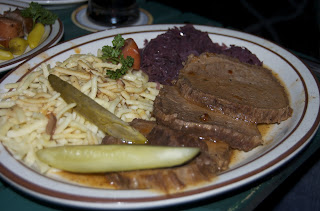Okay, so German food isn’t going to win any awards as the world’s sexiest cuisine. There’s meat, potatoes, meat, cabbage, meat, fish, meat, bread. And more meat. And more bread. And strudels and noodles and bier, oh my! Yeah, I know Germany makes some fine wines, but they’re just not the first thing you think of when someone says, “Hey, let’s go get some German food.”
This assessment is not fair. But it’s easy–stereotypes always are (hah! Look at that. I just stereotyped stereotypes–and it was easy!). Germany is made up of 16 states that cover an area that’s somewhere between the size of California and Nevada, so a truly representative sampling involves a lot more than one trip to one restaurant in Los Angeles. That’s all I have to work with right now, so it’s a point of departure, not the whole shebanginenerinenen.
Himself had other plans that night, so I hooked up with our friends Brian and Kevin and went to The Red Lion in Silver Lake. Brian spent his junior year of college in Germany, and this place takes him back to those salad days (although I’m betting salad didn’t figure into them very much!). I’ve also found that a lot of the area’s German residents love The Red Lion for the food as well as for the brews and the atmosphere, so I figured we’d get a decent representation of German chow there.
I tend not to like beer I can read through, so I ordered their schwarzbier, which quite literally means “black beer.” It’s dark like my favorite, Guinness, but slightly sweet. I prefer the Irish stout, but this black lager was still a good accompaniment to the meat, er, the meal. (It’s helpful when writing about German food that meal and meat are only one letter off!)
We started with a trio of sausages, sweet-and-sour pickles, surprisingly hot peppers and a good sturdy mustard. The German sausage most people seem familiar with is the bratwurst, on the right, which is a standard of tailgate parties and backyard events. It’s larger and not as dense as its companions, the rich and smoky bockwurst in front, and the knockwurst, the smaller, spicier one to the left. I’m thinking that someday a sausage tour of Germany is in order. Each region has at least a few sausages that are distinct from all the rest, and I wouldn’t mind trying them all.
For dessert we shared a piece of schwarzwalder kirchetorte. It’s one of the first desserts I learned to make in culinary school. In fact, I can make it more easily than I can pronounce it. This one was not heavily imbibed with kirchwasser or any other liquor that we could detect, probably because in the United States people tend to frown on their children getting twirly on dessert. Still, chocolate, cherries and whipped cream…..mmmmm….. What’s not to love about that combo?
When you think about it, if you grew up on the East Coast, in the Midwest, in the South–actually, most anywhere in the United States–chances are your standard meal included meat, potato, a veg or two and some bread. That’s very German, very English. Growing up in the rural South, I ate a lot deep-fried this and that. “Spaghetti” was ground beef and tomato sauce poured over noodles that had been broken up before cooking, for ease of eating. No seasonings beyond salt and pepper. And I didn’t have pizza until I was in college. So while the fare we had on this outing was good, it wasn’t some new and exciting combination of flavors. While I’m not of German stock, this food had a familiarity to it.
There’s one thing to be said for these less glamorous foods–they’re more likely to be your comfort food than something pretty and fussy and exotic. While the version of spaghetti I grew up with was in no way authentic–and really quite bland–I can envision times when it would be quite pleasurable to shovel in a bowlful during a time of stress or loss. The same can be said for a plate of spätzle or a slice of schweinebrauten and a mound of mashed potatoes. Sometimes this is really all we need.





















